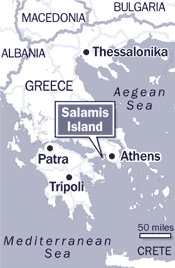
Palace of Homer's hero rises out of the myths (The Times)
ARCHAEOLOGISTS claim to have unearthed the remains of the 3,500-year-old palace of Ajax, the warrior-king who according to Homer’s Iliad was one of the most revered fighters in the Trojan War.
Classicists hailed the discovery, made on a small Greek island, as evidence that the myths recounted by Homer in his epic poem were based on historical fact.
The ruins include a large palace, measuring about 750sq m (8,000sq ft), and believed to have been at least four storeys high with more than thirty rooms.
Yannos Lolos, the Greek archaeologist who made the discovery, said he was certain that he had come across the home of the Aiacid dynasty, a legendary line of kings mentioned in the Iliad and the Classical Greek tragedies. One of the kings, Ajax (or Aias), was described by Homer as a formidable fighter who, at one point in the Trojan campaign, held off the Trojans almost singlehandedly while his fellow Greek Achilles sulked in his tent because his slave-girl had been taken away from him.
The city of Troy is believed to have fallen about 1180BC — at about the same time, according to Mr Lolos, that the palace he has discovered was abandoned and left to crumble. Ajax, therefore, would have been the last king to have lived there before setting off on the ten-year Trojan expedition.
“This is one of the few cases in which a Mycenaean-era palace can be almost certainly attributed to a Homeric hero,” Mr Lolos said.
Fellow archaeologists said that they believed that the ruins were indeed those of a Mycenaean palace. Curtis Runnels, Professor of Archaeology at Boston University, said: “Mr Lolos has really delivered the goods.”
The Mycenaean ruins appear to be at the site where Homer records a fleet of ships setting out to take part in the war on Troy. The Iliad is believed to portray conditions at the close of the dominance of Mycenae, the prime Greek power of the second millennium BC.
The ruins have been excavated over the past five years at a site near the village of Kanakia on the island of Salamis, a few miles off the coast of Athens.
The palace was built in the style of those of the period, including the vast acropolis at Mycenae.
“The complex was found beneath a virgin tract of pine woods on two heights by the coast,” Mr Lolos said. “All the finds so far corroborate what we see in the Homeric epics.”
Homer compares Ajax to a wall and describes him carrying a shield made of seven layers of thick oxhide. Unlike other heroes, he fights without the aid of deities or the supernatural. According to Sophocles, who wrote 800 years after the Trojan War, Ajax committed suicide after the fall of Troy without seeing his homeland again.
Several relics of oriental and Cypriot origin were found at the site at Kanakia, such as bronze armour strips stamped with the emblem of Pharaoh Rameses II of Egypt, indicating trade or possible war in the 13th century BC.
Salamis became famous as the site of a sea battle in 480BC in which the Greek navies destroyed the invasion fleet of the Persian king Xerxes and put paid to the Persian threat.
The other main site where archaeologists claim to have discovered relics of places recounted in the Iliad is at the castle of Pylos in southeastern Greece, believed to be the home of King Nestor.

No comments:
Post a Comment